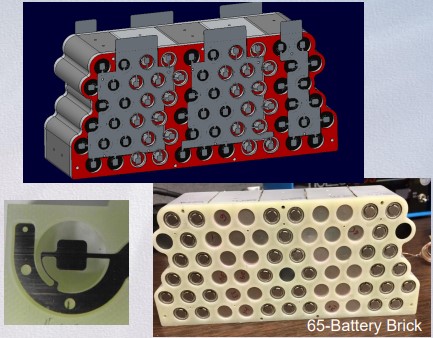
by Iris Su, Project Engineer II, Inventus Power
A recent change in Li-ion battery pack safety is the shift from a focus on just prevention to one that emphasizes prevention and mitigation. Battery pack designers who were once focused on preventing thermal runaway (TR) are now taking increasing measures on preventing single cell failures within the system from cascading into a fire and/or explosion [1]. This is especially evident in medium and large format battery modules that can contain hundreds of cells as the likelihood of one cell failing increases and the potential for damage to equipment and operators is enormous. As the margins of safety increase, so does the cost burden and engineering challenges. In order to design a robust pack that is cost-effective and conforms to the geometric limitations of the system, engineers must consider the specific TR trigger method used and the unique design challenges associated with it.
Currently, the guideline of designing to reduce single-cell failure severity in medium and large format battery packs is to minimize cell can side wall ruptures, eliminate direct cell-to-cell contact, individually fuse cells in parallel, protect adjacent cells from TR ejecta, and prevent flames or sparks from exiting the battery pack enclosure [2]. This can be daunting and perhaps impossible when considering geometry and cost restraints. In those situations, the test set-up should be considered as it greatly affects the resulting release of energy and thus the design method.

A Li-ion cell may ignite for numerous reasons: mechanical abuse, electrical abuse, and thermal abuse are general categories of internal short circuit (ISC) failures that may cause thermal runaway [3]. But even under non-abusive conditions, cells may develop ISC after years of normal operation just as a result of minor contaminants or defects during manufacturing. Even with top tier manufacturers, failures occur in roughly 1 out of every 10 million cells produced and are considered unavoidable [4]. Many of these failures are latent and the cells do not fail until months or years into operation and testing for these types of failures is the most difficult. Controlled initialization of an ISC relevant to field failures is exceedingly difficult but very necessary in order to properly design a battery pack for thermal propagation and many approaches have been taken, each with different outcomes and design challenges.
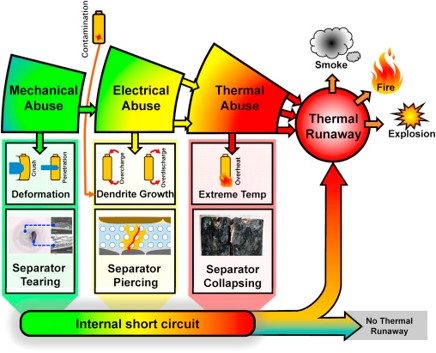
So far, one of the most advanced methods of initiating thermal runaway in a single cell is the “On-demand” ISC test created by NASA and the NREL in partnership with Molicel. This test involves implanting a device into the cell while it is being manufactured and a short circuit can be triggered on command, produces negligible influence on cell safety or performance, and is consistent and reproducible.
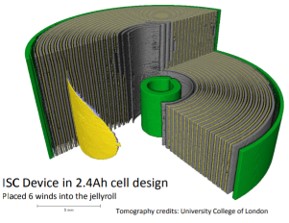
With the On-demand ISC device, multiple types of internal short circuits can be created at specific locations and depths within the cell. Critical risks such as increased probability of side wall ruptures in certain cells have been identified and the test is very relevant to real-world field failures and preventing thermal runaway. Using NASA’s On-demand ISC test, battery-pack engineers would be able to accurately simulate the behavior of a pack when there is single-cell TR and effectively design to mitigate propagation in the pack [5].
While this ISC device has shown promising results in recreating the different types of cell internal short circuits in a controlled manner, it is still not truly reproducible as it requires special cells that have the device implanted by the cell manufacturer. Furthermore, the device fabrication is not entirely automated and custom heaters are required to trigger the short circuit.
Instead, another trigger method used by NASA that has been effective at testing short circuits in single cells is to use heater patches at the bottom of the cell canister to overheat the cell. Because the heater is placed at the bottom of the cell, it does not heat up nearby cells and can be easily applied to a single cell even when it is glued cell-to-cell in an assembled pack. The heater patches contain nichrome wire and can be powered up to 90W, which also reduces risk of heating adjacent cells. This bottom patch heater method has proved to be more effective at causing thermal runaway than traditional methods of overheating cells like heating coils or oven heating. Traditional methods are unable to control the heat to a single cell or even initiate cell venting or TR unless combined with electrical abuse methods like overcharging or over-discharging. Even then, it is difficult to perform a controlled single cell failure in an assembled pack and initialize thermal runaway using heat and electrical abuse [6].
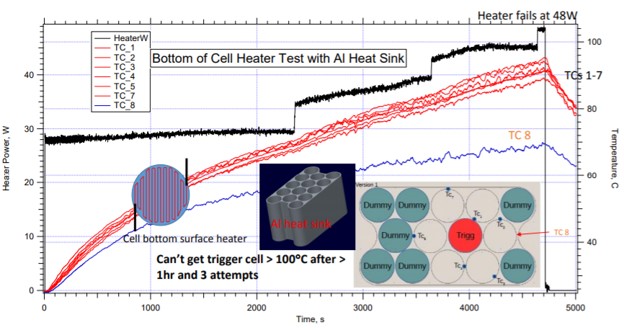
However, like the On-demand ISC device, the bottom patch heater is also not commonly used by regulatory agencies for testing as high power requirements make it difficult to perform. Furthermore, when packs with heat sinks or cell supporters, the bottom patch heater does not always trigger TR and cannot be relied on.
While the aforementioned methods of triggering ISC are still being investigated, the nail penetration test is still the most common and easy to create methods used to replicate ISC and initiate thermal runaway for now. While easy to perform, it is hard to control and prove relevance to the nail penetration test. Even the smallest variations in test setup like cell orientation or penetration speed can greatly affect the result of the test and even determine whether combustion occurs [7]. Such variations make the test extra difficult to pass and design for experiments. In addition, in order to have confidence in the results of the nail penetration test, multiple tests should be performed.
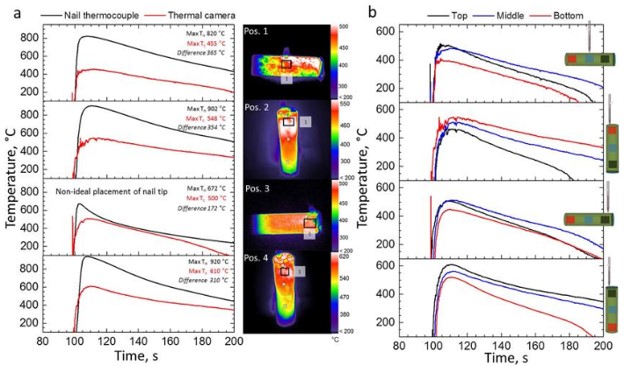
There are a variety of ways to test for thermal runaway in a battery module, and each produce a different result and challenge for thermal propagation management/mitigation. A safe solution that is cost-effective should be designed for the specific trigger method being used.
Inventus Power, founded in 1960, is the leading provider of advanced battery systems for global OEMs. From design & engineering to performance testing & mass production, Inventus Power provides accelerated end-to-end solutions. For more information on custom thermal runaway mitigation solutions, visit inventuspower.com and follow @inventuspower.
References:
[1] NHTSA, “Single Cell Thermal Runaway Initiation (SCTRI),” Page 193
UL1973 states: “37.1 The electric energy storage system shall be designed to prevent a single cell failure within the system from cascading into a fire and explosion of the DUT. This test is applicable to lithium ion technologies.”
[2] E. Darcy, NASA-JSC, 2016, “Passively Thermal Runaway Propagation Resistant Battery Module that Achieves > 190 Wh/kg,”
[3] X. Feng, M. Ouyang, X. Liu, L. Lu, Y. Xia, and X. He, “Thermal runaway mechanism of lithium ion battery for electric vehicles: A review,” Energy Storage Materials, vol. 10, pp. 246–267, May 2017.
[4] “BU-304a: Safety Concerns with Li-ion,” Safety Concerns with Li-ion Batteries – Battery University. Available: https://batteryuniversity.com/learn/article/safety_concerns_with_li_ion.
[5] E. Darcy, NASA-JSC, “Challenges With Achieving >180Wh/kg Li-ion Battery Modules that Don’t Propagate Thermal Runaway or Emit Flames/Sparks,”
[6] J. Jeevarajan, NASA-JSC, 2009, “Limitations of Internal Protective Devices in High-Voltage/HighCapacity Batteries Using Lithium-Ion Cylindrical Commercial Cells,” NESC Technical Bulletin No. 09-02.
[7] H. Döring, M. Wörz, Zentrum für Sonnenenergie- und Wasserstoff-Forschung Ulm, 2018, “Initializing of thermal runaway for lithium-ion cells”.




Real good information, very useful, thank you soooo much
I hope to receive more !!
Many, many thanks